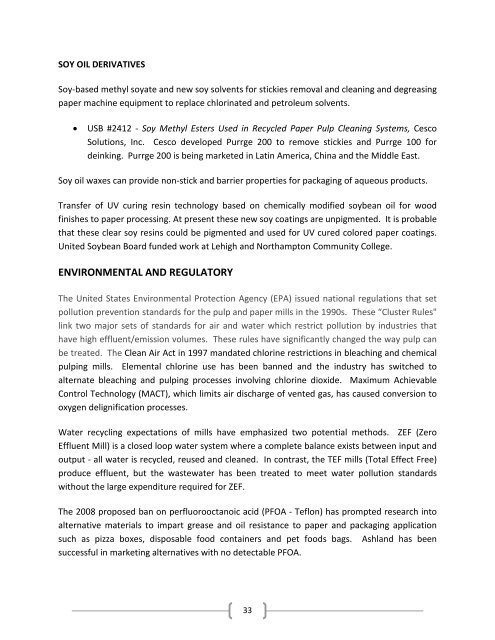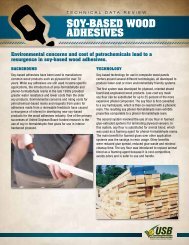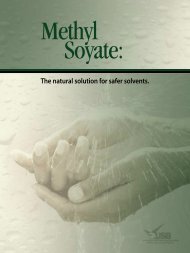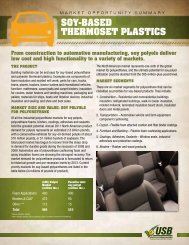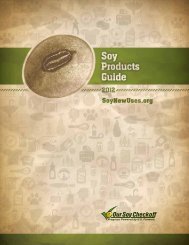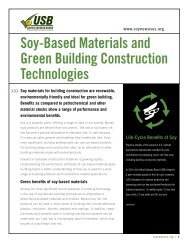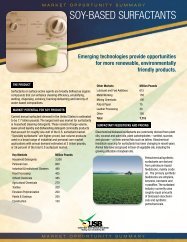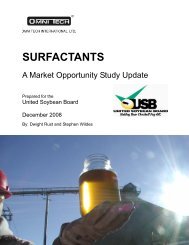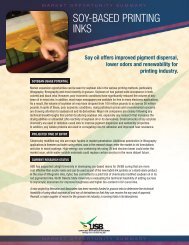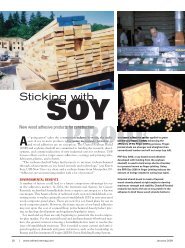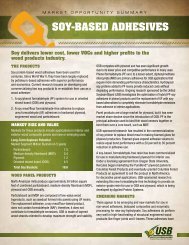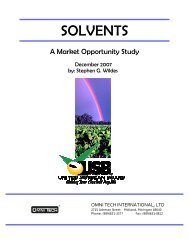SOY CHEMICALS FOR PAPER PROCESSING - Soy New Uses
SOY CHEMICALS FOR PAPER PROCESSING - Soy New Uses
SOY CHEMICALS FOR PAPER PROCESSING - Soy New Uses
You also want an ePaper? Increase the reach of your titles
YUMPU automatically turns print PDFs into web optimized ePapers that Google loves.
<strong>SOY</strong> OIL DERIVATIVES<strong>Soy</strong>-based methyl soyate and new soy solvents for stickies removal and cleaning and degreasingpaper machine equipment to replace chlorinated and petroleum solvents.• USB #2412 - <strong>Soy</strong> Methyl Esters Used in Recycled Paper Pulp Cleaning Systems, CescoSolutions, Inc. Cesco developed Purrge 200 to remove stickies and Purrge 100 fordeinking. Purrge 200 is being marketed in Latin America, China and the Middle East.<strong>Soy</strong> oil waxes can provide non-stick and barrier properties for packaging of aqueous products.Transfer of UV curing resin technology based on chemically modified soybean oil for woodfinishes to paper processing. At present these new soy coatings are unpigmented. It is probablethat these clear soy resins could be pigmented and used for UV cured colored paper coatings.United <strong>Soy</strong>bean Board funded work at Lehigh and Northampton Community College.ENVIRONMENTAL AND REGULATORYThe United States Environmental Protection Agency (EPA) issued national regulations that setpollution prevention standards for the pulp and paper mills in the 1990s. These “Cluster Rules"link two major sets of standards for air and water which restrict pollution by industries thathave high effluent/emission volumes. These rules have significantly changed the way pulp canbe treated. The Clean Air Act in 1997 mandated chlorine restrictions in bleaching and chemicalpulping mills. Elemental chlorine use has been banned and the industry has switched toalternate bleaching and pulping processes involving chlorine dioxide. Maximum AchievableControl Technology (MACT), which limits air discharge of vented gas, has caused conversion tooxygen delignification processes.Water recycling expectations of mills have emphasized two potential methods. ZEF (ZeroEffluent Mill) is a closed loop water system where a complete balance exists between input andoutput - all water is recycled, reused and cleaned. In contrast, the TEF mills (Total Effect Free)produce effluent, but the wastewater has been treated to meet water pollution standardswithout the large expenditure required for ZEF.The 2008 proposed ban on perfluorooctanoic acid (PFOA - Teflon) has prompted research intoalternative materials to impart grease and oil resistance to paper and packaging applicationsuch as pizza boxes, disposable food containers and pet foods bags. Ashland has beensuccessful in marketing alternatives with no detectable PFOA.33


